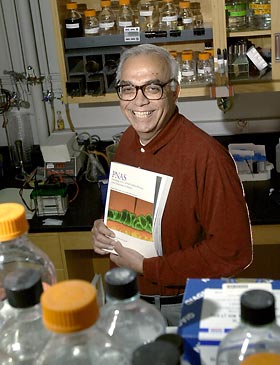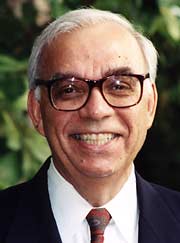UC Berkeley Press Release
Biochemist, PNAS editor Nicholas Cozzarelli has died
BERKELEY – Nicholas Robert Cozzarelli, editor-in-chief of the journal Proceedings of the National Academy of Sciences and a professor of molecular and cell biology at the University of California, Berkeley, died Sunday, March 19, from complications of treatment for Burkitt's lymphoma. He was 67 and died at his home in Berkeley.
 Biochemist Nicholas Cozzarelli, in his Koshland Hall lab, was editor-in-chief of the journal Proceedings of the National Academy of Sciences. (Noah Berger photo) |
A member of the National Academy of Sciences, Cozzarelli was known for his research on how, in his words, "proteins push DNA around." During his career, he discovered the action of proteins that knit DNA together after it has been damaged, create the twisting double helix structure, and tie and untie strands of DNA. He advocated the mathematical study of knots to understand the function of these enzymes and how they cut and splice DNA to create and untangle complex knots.
"This synthesis of biology, with its underlying mathematical foundations, represents one of the most elegant accomplishments in quantitative biology and has provided unprecedented insight into the molecular mechanisms and energetics of many important nuclear processes," wrote his colleague Michael Botchan, UC Berkeley professor of molecular and cell biology, last year. "(Cozzarelli) is a giant in a field that has been transformed by his deep and wide-ranging discoveries."
As editor-in-chief since 1995 of the main publication of the National Academy of Sciences, Cozzarelli changed the journal's methods for reviewing submitted manuscripts, according to Botchan, making it a scientific publication that now vies for prestige with the best.
"Nick deserves almost the entire credit for making PNAS a high impact journal," said Arthur Kornberg, Nobel laureate and Stanford University professor emeritus of biochemistry. Cozzarelli was a post-doctoral fellow in Kornberg's laboratory from 1966 until 1968.
Cozzarelli also was a champion of open access publishing, that is, allowing the public, not just a journal's paid subscribers, to read scientific articles. PNAS was one of the first publications to alter its policy and allow free public access via the Internet, although its high-profile competitor publications have yet to follow suit.
 Nicholas Cozzarelli |
Botchan noted that Cozzarelli represented a true American success story. Born March 26, 1938, in Jersey City, New Jersey, to Italian immigrants from the town of Castelnuovo di Conza, he rose to the top of his field. His father was a shoemaker, while his mother edited telephone books. He was offered a full scholarship to Princeton University, where he graduated in 1960 with an A.B. magna cum laude. He attended Yale University School of Medicine for one year before switching to Harvard Medical School, where he earned a Ph.D. in biochemistry in 1966.
While in Kornberg's laboratory at Stanford, Cozzarelli worked on proteins called ligases that stitch DNA together after it has been damaged. Subsequently, while at the University of Chicago, he and Martin Gellert were the first to show that drugs called quinolones worked by inhibiting an enzyme that makes the DNA double helix form supercoils. Perhaps more importantly, they showed that these drugs also turned the enzyme, called gyrase, into a poison that eventually kills the cell.
During his career he studied many enzymes, collectively called topoisomerases, that coil and twist DNA, or facilitate its melting or relaxation. These manipulations are essential whenever genes are transcribed into messenger RNAs for protein synthesis, chromosomes are duplicated, or repairs made to the damage caused by X-rays or chemical carcinogens.
This work has had significant clinical impact, Botchan noted. Searches for new inhibitors in bacteria and eukaryotes now use purified topoisomerases and poison assays pioneered by Cozzarelli. Today, quinolones such as ciprofloxacin are among the most important antibiotics, and about two-thirds of all cancer chemotherapy regimens contain a topoisomerase inhibitor.
"People rightly focus a lot on how genes are expressed and what the information is that is stored in the double helix. Nick was one of the most creative people in the area of how DNA is itself cared for," Botchan said. "He made very big contributions in understanding how DNA is replicated, how it recombines and is repaired, and how it is forcefully moved from cell to cell."
Cozzarelli came to UC Berkeley in 1982 as a professor of molecular biology, chaired that department from 1986 to 1989, and directed the campus's Virus Laboratory from 1986 to 1990. He authored more than 160 scientific publications, not to mention many editorial commentaries for PNAS.
With funding in 1988 from the National Science Foundation, he founded the Program for Mathematics and Molecular Biology, which helped broaden the boundaries nationally of molecular biology and biochemistry to include more quantitative natural sciences. The program became a forum in which biologists, mathematicians and physicists met to learn each other's concepts, problems and vocabularies, and a school in which young scientists could train at the boundaries between molecular biology, physics and mathematics.
During the past few years, Cozzarelli developed and applied tools such as optical and magnetic tweezers to manipulate single molecules to discover the mechanical properties of the double helix and the enzymes that tangle and disentangle it.
He was a member of many societies and a fellow of the American Academy of Arts and Sciences and the American Association for the Advancement of Science. Among his awards were election in 1989 to the National Academy of Sciences and the 1990 CIBA-GEIGY/Drew Award in Biomedical Research. He was on the editorial boards of many publications, including the first open access journal, PLoS Biology.
Cozzarelli, who would have turned 68 next week, is survived by his wife, Linda Cozzarelli, of Berkeley; a daughter, Laura Cozzarelli-Wood, of Towson, Md.; and brothers, Francis of Buffalo, N.Y., and Angelo of Buffalo Grove, Ill.
A campus memorial symposium will be scheduled for later in the semester.

